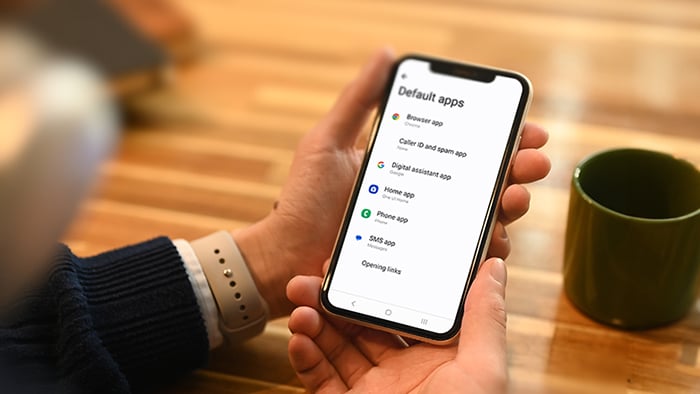- Security
- Privacy
- Performance
What Is a Web Browser?
Once mainly a tool for school and work, the web today is used for everything from answering questions to shopping to video-chatting with friends and family. But while we all use the web, few of us know how it really works. Let’s examine one of the most fundamental tools for exploring the internet: a web browser.
/What-is-a-web-browser-Hero.jpg?width=1200&name=What-is-a-web-browser-Hero.jpg)
Written by
Published on January 28, 2021
Updated on October 11, 2023
Reviewed by
Danielle Bodnar
Published on January 28, 2021
Updated on October 11, 2023
Reviewed by
Antoinette Cocorinos
This Article Contains
This Article Contains
A web browser, also known as an internet browser or simply a browser, is a software application that lets people access the World Wide Web. It’s a one-click window to the entirety of human knowledge — you can search for the answer to any question you might have.
With a web browser, you can browse any website and easily navigate to other sites, similar to how you can browse stores at the mall, lingering in those you like before moving on to visit new ones.
Web browser examples
Web access is as important as having a home address and telephone number. So just about every computer, tablet, and smartphone comes with internet connectivity and a web browser application.
Here, we’ll examine the most popular examples of web browsers on the market to give you an idea of the different types of web browsers available. And we’ve included screenshots of the most popular browsers, just in case you’re wondering what they look like.
Google Chrome
With 70% of global market share, Google Chrome is the most popular web browser. Chrome’s popularity can be partly explained by its fast browsing speeds and easy integration with your personal Google account, making it the most convenient browser for many people. And with the largest library of extensions among the leading browsers, Chrome is also an extremely easy internet browser to modify and customize.
/img_01-Chrome.png?width=600&name=img_01-Chrome.png)
Safari
Safari is the default web browser for all Apple devices: Macs, iPads, and iPhones. While most people don’t have Mac computers, many have iPhones and iPads. In fact, Safari is the most popular mobile web browser in the US. And while using a computer clearly offers a much different experience than a mobile device, Safari’s look and feel is consistent across Apple devices.
/img_02-Safari.png?width=600&name=img_02-Safari.png)
Microsoft Edge (formerly Internet Explorer)
Replacing the old and outdated Internet Explorer, Microsoft Edge is Microsoft’s new flagship browser. This web browser comes standard with any device using Microsoft’s Windows operating system. Edge is built on the Chromium browser platform, which also underpins Chrome and other browsers as well.
/img_03-Edge.png?width=600&name=img_03-Edge.png)
Mozilla Firefox
Once one of the most popular web browser applications in the US — and the successor of Netscape Navigator, one of the earliest commercially successful web browsers — Firefox has recently lost market share to Chrome and Safari. But despite the drop in popularity, Firefox still boasts a small and loyal following while offering browser features similar to its more dominant competitors.
One reason for this internet browser’s staying power could be the fact that Firefox runs on open-source software and features handy tools for developers, making it easy for engineers and other web professionals to inspect and update their websites for security, privacy, and useability improvements.
/img_04-Mozilla.png?width=600&name=img_04-Mozilla.png)
Opera
While never the most popular browser, Opera has built a steady user base over the years. This is due in part to the unique features the browser offers, such as a built-in proxy and ad blocker.
/img_05-Opera.png?width=600&name=img_05-Opera.png)
Avast Secure Browser
All of the browsers listed above have their own private browsing modes, but only Avast Secure Browser makes browsing securely and privately its main attribute, not just an option or afterthought. Its extensive list of security and privacy features includes built-in protection against phishing, web tracking, and browser fingerprinting. It also includes a built-in ad blocker and offers easy-to-set-up automated security alerts.
/img_06-ASB.png?width=600&name=img_06-ASB.png)
Most of these features are enabled by default or can easily be turned on, making Avast Secure Browser the best solution for anyone looking to safeguard their privacy and security online. Give it a spin today and see for yourself.
How does a browser work?
A web browser sends and receives information (data) to and from other parts of the web. The information received is displayed in your browser window. Data is transferred using the Hypertext Transfer Protocol (http), the method that governs how text, images, and video files are transported around the web.
To display information graphically on your device, web browsers feature a user interface, also known as the frontend, where you can click, scroll, and navigate around web pages and websites.
To send and receive data, web browsers also have a less-visible side called the backend. The backend (servers, databases, applications) sends your requests out across the internet and carries the data received back to you so that you can connect to and interact with the websites you want to visit.
The frontend is clean and elegant, as shown in the pictures of web browsers above and from your own experience as you browse the web with your favorite browser. The backend is the scaffolding that supports your browser’s functionality, ensuring that information is processed safely and smoothly.
That’s what a web browser is and how it works. Now let’s focus on the most basic features of a web browser.
To get started, open your web browser of choice by clicking on its application icon — a browser window will open automatically. Alternatively, you can right-click on the icon and select Open from the drop-down menu. Of course, you’re probably using a browser right now as you read this article. In that case, just keep on reading!
What are the most common features of a web browser?
The most common features of a web browser include the browser window itself (also referred to as the user interface), the navigation and address bar, and options to view your history, settings, and other tools.
Pretty much every web browser has those features, so it’s pretty easy to switch your default browser on PC or change your default browser on Mac without much confusion. And most browser features also have a browser shortcut, which you can use for easier access.
The web browser window
The web browser window (or browser user interface) is how you view and navigate individual web pages. You can visit additional web pages by opening other windows, or by creating new tabs in the same browser window.
You can have multiple windows open in multiple browsers — the number of pages you can have open is limited only by your computer’s processing power and internet connection.
Address/search bar
/img_07.png?width=400&name=img_07.png) At the top of the web browser window, you’ll see a long text bar. This is the address (or search) bar where you can enter a website’s address (URL) — like avast.com. You can also enter search terms here, and your browser will conduct a search via your default search engine.
At the top of the web browser window, you’ll see a long text bar. This is the address (or search) bar where you can enter a website’s address (URL) — like avast.com. You can also enter search terms here, and your browser will conduct a search via your default search engine.
Try typing the search query “What is a web browser,” and take a look at the list of results that surfaces.
Navigation buttons
/img_08.png?width=400&name=img_08.png)
Next to the address bar, you’ll see different buttons on the right and left sides. On the left side, the arrows represent forward and back buttons, which take you back to the previous web page you were viewing, or forward to the page you were on before you went back.
These navigation arrows are greyed out if the particular action isn’t possible.
/img_09.png?width=400&name=img_09.png) The third button changes depending on whether a page is loading or has already loaded. If the page is loading, you’ll see an X: click this button to stop loading the current page (this is useful if you don’t want to wait for all the page’s elements or content to load).
The third button changes depending on whether a page is loading or has already loaded. If the page is loading, you’ll see an X: click this button to stop loading the current page (this is useful if you don’t want to wait for all the page’s elements or content to load).
If you see a looping, circular arrow, click it to refresh the page. Refreshing the page will display new information if the page’s content has been updated since you first landed there (this is helpful if you’re on a news website). Mac users will notice that Safari places its refresh button on the right.
/img_10.png?width=320&name=img_10.png) On the right side of the address bar, there are the minimize, maximize or restore down, and close buttons, respectively. Clicking the minimize button sends the page to the bottom of the screen and out of view.
On the right side of the address bar, there are the minimize, maximize or restore down, and close buttons, respectively. Clicking the minimize button sends the page to the bottom of the screen and out of view.
The maximize button makes the window fill the entire screen of your computer — or if your browser window is already maximized, it makes the size of the window smaller so you can see some of your desktop background.
The close button closes the window, including all tabs that may be open within it.
Other features of a web browser
Most web browsers also come with a bookmarks bar, where you can save URLs to visit again later, download options, and options to view and erase your browsing history — the list or collection of all the web pages you’ve visited while using that browser.
You can also add different features, called add-ons or extensions, to enhance your browsing experience. Some popular browser security extensions include ad blockers, antivirus tools, and anti-tracking tools.
Setting the default search engine of a web browser
Want to use Microsoft Edge, but not a big fan of Bing? The good news is there’s no need to navigate to Google every time you have a search query. You just need to know how to change your web browser’s default search engine.
To change your default search engine, click the menu button in the top-right corner of your browser window, click Settings, navigate to the search engine settings, and then customize your preferences to update the default search engine for your web browser.
/img_11.jpg?width=664&height=205&name=img_11.jpg)
History of web browsers
While the terms internet and web are used almost interchangeably these days, one actually came before the other. The internet, also known as the network of networks, is the network that lets computers — and smaller networks of computers run by governments, companies, and other organizations — communicate with one another.
The internet can be accessed in a variety of ways. The World Wide Web, or web for short, is just one way computers can access the internet to send, receive, and share information. While we use the web to access the majority of the information and services we get on the internet, it’s not the only way to get there.
The internet, also known as the network of networks, is the network that lets computers — and smaller networks of computers run by governments, companies, and other organizations — communicate with one another.
What was the first web browser, then? As a matter of fact, the first web browser was actually called World Wide Web, and it was developed by Tim Berners-Lee in 1989. While the name of the specific web browser didn’t last, the legacy lives on today, as most web addresses start with www, which stands for World Wide Web. Several other web browsers followed in the early 1990s.
The real game-changer, though, was NCSA Mosaic, which allowed multimedia graphics, such as text and images, to be displayed together over multiple protocols. This feature helped popularize internet use among non-tech-savvy users, and it helped put web development on the path toward the user-friendly ubiquity it enjoys today.
While the Mosaic browser itself didn’t last, its original creators developed the project further — and so Mosaic became the Netscape Navigator browser and finally Mozilla Firefox.
For the most part, other than a sleeker design and faster speeds, the basic web browser hasn’t changed all that much since its earliest iterations a couple of decades ago. What has changed are the different features and extensions that web browsers offer, as well as the number and variety of websites you can visit.
Is privacy and security important in a web browser?
Now that you know what a browser is and how it works, you should know that yes, privacy and security are extremely important in a web browser. A web browser is your window to the web, so, just like an open window in your car or house, an unsecured browser leaves you vulnerable to security breaches and invasions of privacy. That’s why you should always keep your browsing secure.
What sort of things do you need to watch out for? On the milder side, many websites use cookies to track your online activity and use that data for targeted advertising. You have some control over this, because web browsers allow you to delete cookies and manage your cookie settings. Recently, advertisers and data brokers have begun investing in even more invasive tracking methods like browser fingerprinting — which happen invisibly and without your consent.
Additionally, hackers are an ever-present danger online. With so many of us entering sensitive information into our web browsers — usernames, passwords, credit card numbers, etc. — it’s important to use strong antivirus software. Additionally, you can make your entire browsing experience private and more secure. For example, major browsers allow you to set your own DNS over HTTPS service to prevent man-in-the-middle attacks and block other threats.
Try Avast Secure Browser and browse with confidence
All popular web browsers have the option to browse privately, and most are compatible with ad-blocker add-ons and antivirus software to help make your browsing more secure. But Avast Secure Browser has these features built-in, so you’re secure on every site you visit.
Avast Secure Browser automatically blocks all ads to improve page-load times and prevent malvertising. And, with its advanced privacy and security protections, you’ll be safe and secure while shopping and banking online.
You also have the option to block online tracking as well as malicious websites and downloads. And Avast Secure Browser’s smooth and fast load speeds mean that you won’t be interrupted or delayed while browsing. What’s more, it’s free and easy to download.
Now that you know more about what a web browser is, start browsing more securely today.
Browse the Web Securely and Privately
Install free Avast Secure Browser to enjoy smooth, secure, and private web browsing on your iPhone or iPad.
Browse the Web Securely and Privately
Install free Avast Secure Browser for Android to get smooth, secure, and private web browsing.
Browse the Web Securely and Privately
Download free Avast Secure Browser for Windows to get smooth, secure, and private web browsing.
Browse the Web Securely and Privately
Download free Avast Secure Browser for Mac to get smooth, secure, and private web browsing.
This Article Contains:
More Privacy Articles

How to Remove Yahoo Search from Chrome

How to Delete Search History on iPhone and iPad

What Is DuckDuckGo and Is It Safe?

How to Stop Pop-Up Ads on Android Phones

What Is the about:blank Page? How to Use or Remove It

The Fastest Browsers to Use in 2025

How to Block Websites on Google Chrome

How to Make Chrome Your Default Browser

How to Fix “Your Connection Is Not Private” on Any Browser

How to Update Chrome on PC, Mac, Android, or iPhone

How to Download Chrome on Your Mac

How to Clear Your Browsing and Search History
Get smooth and private web browsing with Avast Secure Browser for iPhone and iPad
Avast
Secure Browser
Get smooth and private web browsing with Avast Secure Browser for Android
Avast
Secure Browser
Browser
Privacy
Danielle Bodnar
28-01-2021